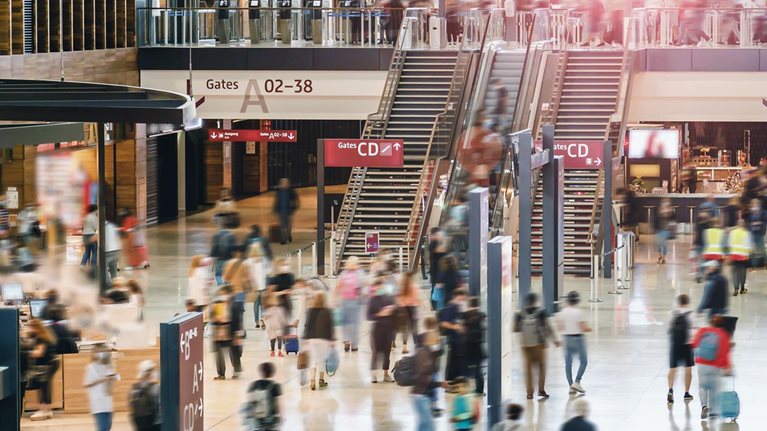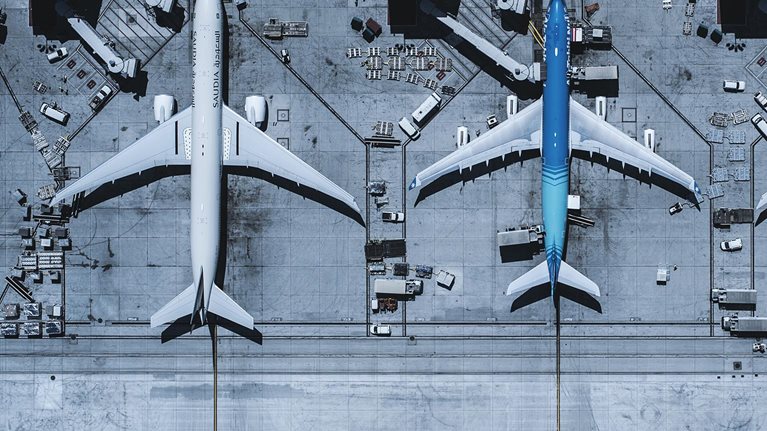There’s no sugarcoating the diagnosis: airlines are the biggest destroyer of value among all aviation subsectors. McKinsey’s analysis of the aviation value chain in 2020—our latest—paints a grim picture. All subsectors save freight forwarders and cargo airlines suffered huge losses (Exhibit 1).

Of course, this is expected. The COVID-19 pandemic is entering its endemic stages in some parts of the world at the time of writing, and airlines hemorrhaged $168 billion in economic losses in 2020. Although the temptation is to pin the blame solely on the pandemic-induced plunge in passenger traffic, that would be to ignore the airline industry’s underlying and long-term health problems.
This article, the first in a two-part series, provides an overview of global aviation’s performance during the pandemic, by subsector. The second article explores what airline executives could consider doing to generate more value for their carriers—for instance, examining their cost base and accelerating capital turnover. Fiscal year 2021 data are not yet available for all the companies covered in this analysis, so this article draws insights mostly from the 2012–20 data, supplemented by observations of key developments in 2021.
Breaking down the global aviation value chain by subsector
Since 2005, McKinsey, often in collaboration with the International Air Transport Association (IATA), has assessed the performance of the entire aviation value chain—that is, the degree to which each subsector earns its cost of capital. We have looked at all value chain players: original equipment manufacturers (OEMs) of aircraft; lessors; air navigation service providers (ANSP); airports; catering operations; ground services; maintenance, repair, and overhaul (MRO); airlines; freight forwarders; and global distribution system (GDS).
As a measure of value creation, we look at economic profit. This is the difference between the returns a company makes after taking into account its invested capital and the alternative returns of equal-risk opportunities investors have access to, measured by the weighted average cost of capital (WACC).
As we have noted, the pandemic wreaked financial devastation across the aviation value chain, most notably for airlines. All subsectors reported massive losses in 2020, except for freight forwarders and cargo airlines, which benefited from a rise in demand for air cargo (Exhibit 2). Even previously reliable value creators, such as airports and manufacturers, were not spared the pandemic’s economic impact.

We found that the degree of devastation varied according to the variability of the costs borne by companies in a subsector and the revenue flows to which they have access. Companies that relied more on flights for their revenues still made money from cargo flights and half-full passenger flights and were therefore less adversely affected than companies that depended more on passenger flows. Similarly, companies with high fixed costs struggled more because they could not easily shed the financial burden of keeping operations running smoothly.
Airlines
Although the COVID-19 pandemic hit airlines harder than any other aviation subsector, it wasn’t doing particularly well before then. From 2012 to 2019, despite a favorable environment of strong economic growth and low fuel prices, airlines were bleeding $17 billion in economic profit a year, on average. Of the 122 carriers we studied, 77 percent were value destroyers (Exhibit 3). But the average losses of airlines before the pandemic were only around one-tenth of their $168 billion in losses for 2020. Their revenues plummeted by 55 percent, setting the subsector back, in nominal terms, roughly 16 years—to 2004.

All regions contributed to the overall losses in 2020—including North America, which outperformed other parts of the world from 2012 to 2019, when its airlines registered a cumulative $44 billion in economic profit (Exhibit 4). Five of the world’s ten top-performing airlines during this period were based in the United States, because years of consolidation and restructuring had left the North American market with a few big leading players. Nonetheless, the pandemic did not spare them, and they lost $63 billion in 2020.

While the full data from 2021 is still unavailable, we expect airlines’ 2021 performance to remain weak, with net losses of around 11 percent. The IATA estimates that even though global revenues for airlines rose by 27 percent last year compared to 2020, they were still 44 percent less than what they were in 2019.
The reasons for the persistent weakness of airlines even before the pandemic are well documented. The subsector grapples with high capital intensity but fluid supply and low entry barriers. Furthermore, the large field of carriers means that suppliers—OEMs and airports—have stronger negotiating power. On the customer side, passengers hold significant buying power and are mostly price driven, an added challenge in an age when passengers can easily compare the ticket prices of different carriers online. Despite the best efforts of airlines to differentiate themselves, an airline seat remains relatively commoditized. In addition, national carriers may find that the interests of their countries may sometimes supersede their business interests. For example, a national carrier may continue offering flights on unprofitable routes, to its own distress and that of other airlines offering the same route.
What’s more, airlines are especially vulnerable to external shocks beyond their control, because they have high fixed costs and mostly variable revenues. The Gulf War, 9/11, the 2010 volcano eruption in Iceland, and the 2008 global financial crisis all affected the airline subsector dramatically, though not as profoundly as the pandemic did.
Airlines need to bolster their resilience. They could increase their cash reserves, voluntarily or by regulation, which would reduce the need for bailouts every time a crisis hits. They could also work to make their operations more agile and nimble—that is, they could improve their ability to reduce supply quickly and cost-effectively when demand abruptly falls, by increasing the variability in their cost base. (The next article will explore this topic further.)
Airports and ANSPs
Until the pandemic’s onset, airports created more value than any other aviation subsector in most regions except North America (Exhibit 5). Globally, airports enjoyed annual aggregate economic profits of $5 billion, on average, from 2012 to 2019, when their economic-profit margins were around 3 percent. Airports in the Asia–Pacific region were especially strong performers and very competitive because they benefited from high demand and a favorable regulatory climate. But the pandemic exposed an inherent challenge in the business model of most airports: high fixed costs and mainly variable revenue flows. Dwindling traffic led to heavy economic losses of $32 billion, or 45 percent, in 2020. The Airports Council International estimates that airports’ performance improved somewhat last year, drawing in 26 percent more revenues than in 2020. However, last year’s revenues remained more than 50 percent lower than in 2019.

ANSPs, which manage the safe flow of air traffic, are mostly government-run entities, though some countries, including the United Kingdom and Canada, have private-sector players. These air traffic operators have significant infrastructure costs and use highly trained labor, which generally means high and fixed overheads. Before the pandemic, the subsector managed to achieve marginal profitability—an average of around 0.3 percent in economic profit from 2012 to 2019. Since the revenues of this subsector are mostly variable and linked to aircraft movements, it suffered significant losses in 2020.
Freight forwarders and cargo airlines
The sole bright spots are the freight forwarder and air cargo subsectors. In 2020, both managed to generate healthy economic profits: for freight forwarders, 4 percent; and air cargo carriers, 9 percent. In fact, the only five airlines that reaped profits in 2020—AirBridgeCargo, Atlas Air, Cargojet, Cargolux, and Kalitta—were cargo carriers.
Before the pandemic, the performance of the freight-forwarding subsector was high and relatively stable, with an annual economic profit averaging $2 billion from 2012 to 2019, or a margin of 2.2 percent. Despite some consolidation and M&A over the years, this is still a largely fragmented market in which the top five companies by revenue had a 27 percent share in 2019. Many companies have an asset-light model, which improves their return on invested capital (ROIC) thanks to low levels of invested capital. Large players, such as Expeditors and Kuehne+Nagel, enjoy consistently impressive profit margins.
During the pandemic, robust demand for air cargo was initially driven by protective personal equipment (PPE) and medications, and later by challenges in the ocean-shipping supply chain and strong growth in e-commerce sales. The supply of air cargo fell as the number of grounded passenger planes rose, constricting belly capacity and raising rates (and profits for freight forwarders).
Globally, air cargo yields rose by 40 percent year on year in 2020, and by an additional 15 percent last year. Load factors were also up significantly, by ten percentage points in 2021 compared to 2019. We expect cargo yields to drop over the next two to three years but remain above 2019 levels due to a continuing gap between supply and demand.
Manufacturers and lessors
Aircraft manufacturers were the third-weakest subsector in 2020, incurring $12 billion in losses. The reason is straightforward: financially struggling airlines place fewer orders for new aircraft and defer deliveries. Orders for commercial aircraft dropped by around 55 percent in 2020 from the previous year’s level, while the number of deferred aircraft deliveries increased fivefold. Last year, orders picked up but were still 10 percent below their 2019 levels. There were also twice as many deferrals compared to two years before.
Lessors were middling performers before the pandemic, neither reaping large profits nor incurring significant losses. The subsector came under considerable pressure during the pandemic. Many airlines asked for—and received—lease payment deferrals. Rates for new aircraft leases were much lower because of the oversupply of aircraft; for instance, lease rates for widebody aircraft (such as the Boeing 787-9) fell by around 35 percent in 2020 from the previous year’s level, recovering only by 10 percent last year. Worst of all, many lessee airlines, especially in Asia, were in deep financial distress and also sought to renegotiate contract terms, with a preference for power-by-the-hour contracts. Some airlines went through Chapter 11 (or similar bankruptcy proceedings) to restructure their leases.
GDS providers
High barriers to entry protect the providers of the global distribution systems that grease the wheels of travel by making it more seamless to book tickets and hotel stays. Private-equity investors have been active in this subsector, pumping in the capital to make it fairly stable and high performing. It raked in average annual economic profits of around $1 billion, equivalent to a margin of 10.5 percent, from 2012 to 2019.
Airlines—the core customers of GDS providers—have been trying to steer more traffic toward their own channels as a way to ameliorate intensifying cost pressures and to establish a direct link to their customers. But such efforts have yielded mixed success for airlines because the majority of business travel, the highest-yielding passenger segment, is booked through indirect channels, to the benefit of GDS providers.
All forms of travel, including the high-yielding corporate trips, plunged during the pandemic, so GDS providers incurred economic losses in 2020. Yet the drop in profitability, though significant, was less dramatic than it was in other subsectors of the aviation value chain because many GDS providers also have access to revenue streams (from airline IT systems, for example) less directly dependent on air travel demand.
Catering, ground services, and MRO providers
Subsectors with lower fixed costs fared better, even though revenue flows decreased because of lower passenger traffic or fewer flights. The revenue flows for catering and ground service companies are highly dependent on passenger traffic and flight volumes, for example, but much of their workforce consists of contract workers, so the fixed costs of their operations are lower than those of players in other subsectors. This flexibility allowed these companies to partially offset the losses incurred though depressed air traffic during the pandemic. The losses of catering and ground service companies ($2.4 billion and $3.2 billion, respectively) were therefore smaller than those of companies in many other aviation subsectors.
MRO providers were fairly stable value creators before COVID-19. In nonpandemic periods, most airlines choose to keep their flight services to cover their high fixed costs even when travel demand is low. They may tighten their margins by lowering fares in a bid to fill planes. Regardless of whether or not a plane is full, MRO providers still benefit because airlines continue to require their services, which depend more on flight activity than on passenger volume. This generally gives MRO revenue streams greater stability than those of subsectors more dependent on passenger traffic. Still, aircraft activity fell so drastically in 2020 that MROs collectively suffered an economic loss of $3.6 billion. Revenues for the commercial MRO market did improve by 40 percent in 2021, but total recovery to 2019 levels is not expected until 2024.
In today’s highly connected world, international mobility is the norm. But large global shocks will probably become more frequent. As global aviation rebuilds itself, resilience must clearly be a top priority. In the next article, we’ll suggest ways to help airlines enhance their performance by drawing lessons from the value-creating subsectors.


